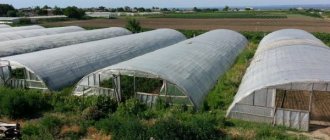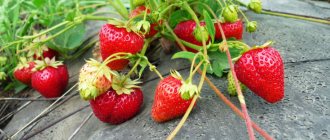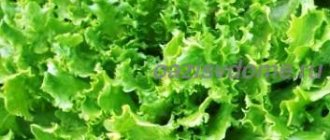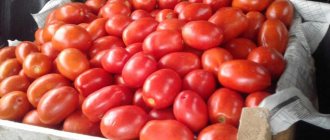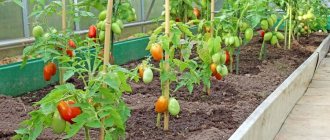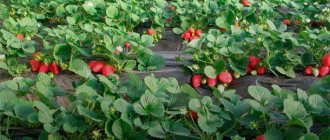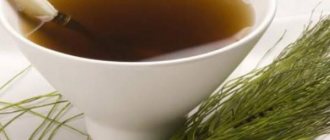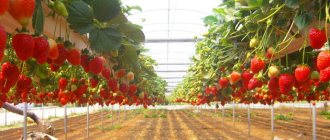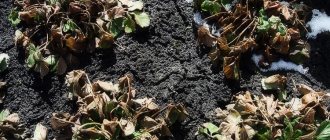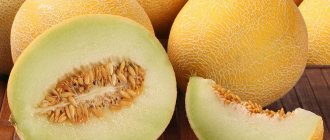What does self-pollinating strawberry mean?
Not every available variety of strawberry is able to successfully grow and bear fruit in a greenhouse. There are several criteria for selecting the desired option, the most important of which is self-pollination. In order for fruit to set, pollination must occur during the flowering period: the transfer of pollen from the anthers to the stigma.
There are two types of pollination:
| Cross | Self-pollination |
| Fertilization is possible only through the transfer of pollen from the stamens of a flower of one plant to the pistil of a flower of another plant. Cross pollination requires the presence of pollination agents, which are usually insects. | Fertilization occurs when pollen is transferred from the anthers to the stigma of the same flower or another, but on the same plant. In this case, you can do without pollination agents. However, their presence can increase the number of pollinated flowers and increase yield. |
What types of strawberries are there?
Strawberries growing in nature are dioecious plants, having male and female plants. The berries are formed only on female bushes; they are oblong, dark red, with a peculiar musky flavor. Wild garden or meadow strawberries are wild berries that were collected in ancient times. And today there are those who like to feast on forest gifts.
But the times of wild-growing forms have long since “sunk into oblivion” and today gardeners choose modern varieties of garden strawberries for their plots. Thanks to well-organized breeding work, a huge number of them have been created. The general classification looks like this:
- remontant;
- large-fruited;
- early;
- average;
- late.
From this list, strawberries are selected based on winter hardiness, taste, large fruit, juiciness and other indicators. It is important to be able to understand this “kaleidoscope” and choose the appropriate varieties for your site. It is better if there are several of them, so that you can alternate the strawberries according to their ripening dates.
How to choose the right variety of self-pollinating strawberries for greenhouses
Self-pollination is an important, but not the only condition. When choosing the right variety, you must take into account that strawberries will have to grow and bear fruit in a special microclimate, and it must be able to adapt to it.
Growing conditions
The owner of the greenhouse will try to create the most comfortable environment for his green pets, but his possibilities are not unlimited.
Most private home-made structures have the following disadvantages that strawberries will have to put up with:
- small area and, accordingly, close fitting;
- insufficient lighting;
- lack of fresh air;
- cold soil (in winter);
- high humidity.
Regional affiliation
Considering all of the above, you should not choose capricious southern varieties for the greenhouse. It is better to opt for early-ripening strawberries, aimed at growing in the middle zone.
In this case, the ability to produce an early harvest is unimportant; other advantages characteristic of these varieties are more important:
- small bushes;
- unpretentiousness;
- short growing season;
- cold resistance;
- ability to cope with a small amount of sunlight;
- resistance to fungal diseases.
Tips and tricks
To get a good harvest, it is better to take day-neutral strawberry varieties.
- The plant needs intensive care.
- Strawberry bushes grown all year round age quickly, so it is not worth keeping them in one place for more than 5 years. Ideally, you need to plant new plants every year.
- It is typical for Moscow strawberries and some other species that diseases adapt to the variety if one variety is planted in one place. Therefore, every year it is worth replacing the variety with another.
- Weed species of plants - “Zhmurka”, “Dubnyak”, “Suspension” - can get into the garden. They are subject to removal.
- It is best to prepare seedlings for next year during harvest.
Requirements for greenhouse varieties
Strawberries for greenhouses (varieties for such conditions must be self-pollinating and early ripening) should produce good harvests several times a season and be distinguished by high-quality fruits.
Repairability
Repairability is the ability of a plant to bloom and bear fruit several times per season. In contrast to varieties that produce 1 (short-day strawberries) or 2 (long-day strawberries) harvests per year.
In open ground, remontant strawberries produce 4 harvests per season, stopping fruiting with the first frost, and in a warm greenhouse microclimate the process of formation and ripening of berries can continue all year round.
Maintenance is a prerequisite for year-round cultivation. Non-repairing varieties can also be grown in a greenhouse, but only to obtain a harvest earlier or to extend the fruiting period. However, using them for all-season cultivation is unprofitable.
High yield
If, when planting in open ground, you can get a bountiful harvest by increasing the size of strawberry plantations, then this is impossible for a greenhouse. The space in it is limited, and every centimeter of space must be used to maximum benefit. Therefore, you will need to select a variety that can produce a large amount of berries at minimal cost.
When growing in greenhouses, crops with a yield of at least 2 kg of strawberries per bush are used. For comparison: when grown in open ground, an indicator of 1.5-2 kg per 1 m2 is considered good.
Commercial qualities
These criteria are more important provided that greenhouse strawberries are grown for sale.
Berries will become a popular product and will attract buyers, despite the “winter” prices, if they have the following advantages:
- average berry size;
- their correct shape;
- elastic dense pulp;
- high taste qualities;
- transportability;
- ability to be stored for several days.
Strawberry business: features
Everyone loves strawberries, especially children. At the same time, not only juicy and fresh berries are respected and loved, but also preparations from the fruits of this crop - preserves, jams can become an excellent culinary ingredient or a real table decoration in winter. And “their own” fresh berries in the cold months are completely unattainable for many - unless they defrost frozen ones, but that’s a completely different story. That is why fresh and aromatic strawberries have always been and will be in great demand in the market, especially in winter.
Strawberries in their own juice - a delicious treat for sale
In a typical summer cottage, the strawberry season usually begins in early or mid-summer. If you plant the bushes in a greenhouse, you can get another harvest of berries before the cold weather. But when the warm days are over, strawberries can only be found on store shelves. And, it is worth noting, sometimes for a very immodest price. That is why the strawberry business can rightfully be considered an excellent way to make money.
On a note! Profits from strawberries can be made all year round. In the summer, this is the sale of berries for preparing preparations, but in the winter, most likely, they will end up on the table fresh.
If you believe the statistics, then every year there are more and more strawberry lovers in Russia. The consumption rate of this berry is constantly increasing by about 30%. This is why the idea of investing in strawberry farming is a pretty good one. Moreover, organizing such a business is not that expensive even for a novice businessman, especially if he is an avid gardener who is well acquainted with growing strawberries. Moreover, sometimes you only need to make a capital investment once.
Strawberry
On a note! Don't expect immediate profit from growing strawberries. First you need to work hard so that you can then enjoy the fruits of your labor.
However, it is important to remember that strawberries are a capricious plant; it is important for them to receive constant attention and proper care. Otherwise, there is a high risk of losing everything. But a plantation that is carefully looked after will repay you handsomely, giving you a large harvest.
The best way to grow strawberries for profit is to cultivate them in a greenhouse.
Advantages of strawberry business in a greenhouse:
- the opportunity to get a large harvest from a modest area - about 50 tons of berries can be collected from 1 hectare of soil;
- good demand for products;
- independence from weather conditions and climatic zones - the crop can be harvested throughout the year;
- minimal investment in an already built business;
- fairly quick payback;
- the opportunity to find a regular consumer and establish regular sales of goods.
Strawberries are always in demand
Disadvantages of growing strawberries as a business:
- large capital investments at the initial stage;
- careful and careful care of plants is necessary, the correct pollination process and long daylight hours (or the organization of additional lighting) are especially important.
In order to organize a strawberry growing business, you will have to worry about preparing permits. Of course, you can cultivate this berry illegally, but then you are unlikely to have regular customers, and it will be difficult to expand your business, because you will not be able to legally open retail outlets. The easiest way to register an individual entrepreneurship at first. At the same time, since you will be engaged in agricultural activities, your taxation will be more lenient.
Forms of agribusiness
State subsidy scheme for agricultural projects
Prices for strawberry seeds
Strawberry seeds
Video - Unified agricultural tax
On a note! You will also need official registration of an enterprise to take out loans from a bank or receive various subsidies and subsidies for small businesses - now similar programs operate almost throughout Russia.
Lending to individuals running private household plots
How to make money on strawberries
To grow strawberries, you will also need a plot of land of at least 120 m2, on which you will install industrial greenhouses, which should be equipped with racks for growing berries, lighting fixtures, and a drip irrigation system (to simplify the process of caring for the plantation at least a little). You may also need various gardening tools and labor - all this is important to take into account when creating a business plan and calculating profitability periods.
Strawberry business in a greenhouse
You can rent a plot of land or grow berries on your own (to begin with, in small quantities). But it is better to immediately tune in to capital production, since “everything that is done for a while remains forever.” This is our mentality.
It is also important to think about how to ensure a constant water supply for the plantation. There is no point in installing it far from pipelines or wells, since you will spend a lot of money on the supply of life-giving moisture.
Drawing up a water supply system plan will allow you to visualize the location of all the necessary elements
Prices for drip irrigation systems
drip irrigation systems
You will also need equipment for storing the collected berries until they are sold. With an established sales system, it will be snapped up quickly, but until it is transferred to a store or restaurant, it needs to be stored somewhere.
Strawberry storage
You may also need, among other things, various fertilizers and additives for plants, and, of course, you must buy the plants themselves. You can grow strawberries from seeds yourself or purchase already grown seedlings and simply plant them on your plot. In the second case, fruiting will begin earlier, but the cost of purchasing planting material will be higher.
Picking strawberries in a greenhouse
Methods of growing in a greenhouse
Protected soil gives the gardener many advantages:
- growing strawberries all year round;
- protecting the plant from the negative effects of aggressive weather factors;
- higher yields (on average 25% higher than for ground strawberries);
- the ability to choose a growing method.
Growing in soil
The simplest method, but requiring large areas and the use of equipment capable of warming the soil to the desired temperature. To ensure that the plants receive maximum light and heat, the beds are placed in the direction from north to south. Their optimal width is 1 m.
The preparation of the beds is carried out according to the following algorithm:
- Fertile soil is removed.
- A layer of crushed stone (6 cm thick) is poured into the resulting trench.
- A layer of sand (10 cm) is placed on it, and even higher - a layer of chernozem (previously excavated soil).
- Holes are created 10 cm deep, located in a checkerboard pattern at a distance of 15-20 cm from each other.
- Fertilizers are placed at the bottom of each hole.
Typically, store-bought nutritional mixtures containing calcium, nitrogen, and phosphorus are used. From organic matter, you can take humus or manure-peat compost.
As seedlings, seedlings harvested independently or purchased from a nursery are used, which are planted in holes to the level of the rosette, no higher or lower, and sprinkled with soil.
Growing in a barrel
Strawberries for greenhouses (there are many varieties of berries) can be grown vertically. It will save space, but will require the creation of a perfect irrigation system.
Several holes are made in a barrel filled with nutrient soil, sufficient for planting strawberry seedlings. A hose connected to the drip irrigation system is supplied to the height of each level in advance.
Growing in bags
Advanced Dutch technology, which proposes using plastic bags for growing strawberries, allows you to more rationally distribute space in the greenhouse and save on heating. This method will require the creation of full ventilation, since in its absence the high temperature and humidity of the soil inside the bags will lead to it starting to rot.
Bags filled with soil are installed vertically or laid horizontally. To plant strawberry seedlings, circular holes are made in polyethylene at a distance of 20 cm from each other, where the seedlings are planted. Instead of bags, you can use boxes, containers, and pipes. A drip system is used for irrigation.
Hydroponic growing
A modern method, radically different from those described above, in that in this case soil is not used; the source of all the substances necessary for the plant is a nutrient liquid circulating through pipes, which is supplied using pumps to cups with filler in which strawberry seedlings are placed.
The method saves space, eliminates a number of labor-intensive operations (weeding, loosening, watering), but is complex and expensive to implement.
Diseases, pests and their control
The greenhouse isolates the strawberries from the outside world, and therefore from access to pests. But diseases can still attack her. They usually arise due to non-compliance with the rules for caring for the crop.
Among the diseases are:
- brown spot (control method: use Actellik or Topaz according to the instructions);
- powdery mildew (control method: mix milk with water in proportions of 1 to 10 and treat the affected bush with the mixture);
- white rot (treat the bed with “Derozal”, “Horus”, “Svitich” according to the instructions).
To prevent the occurrence of illnesses, it is necessary to regularly ventilate the greenhouse to avoid increased humidity. Also, for preventive purposes, treatment with fungicides should be carried out.
As you can see, growing strawberries in a greenhouse is a troublesome and expensive task. But all the efforts and resources spent quickly pay off thanks to the opportunity to obtain a high-quality harvest of tasty berries all year round.
Features of planting and further care
With all the advantages of greenhouse cultivation, it should be taken into account that it will require:
- costs for arranging a greenhouse;
- maintaining the required parameters of temperature, humidity, illumination;
- renewal of planting material.
In order for the investment to pay off, you need to create optimal growing conditions for strawberries.
Soil preparation and planting
Strawberries of self-pollinating varieties for greenhouses love sandy and loamy soils with a slightly acidic reaction. You can use garden soil on which cereals grew.
It is not recommended to take soil from beds previously allocated for:
- pepper;
- tomatoes;
- potatoes;
- other nightshades.
If you want to get an ultra-high yield and get by with a minimum amount of fertilizing, it is advisable to prepare a special nutrient substrate.
To do this you need:
- Fill the container with straw and chicken droppings, add warm water and leave for a month.
- Stir the mixture twice.
- Add chalk, urea, and gypsum to the resulting mass.
- Disinfect the substrate by heating it to a temperature not higher than 60°C.
The prepared soil is used to create the top layer of the beds. Next, holes 10 cm deep are formed in it at a distance of 20 cm from each other, into which seedlings are planted.
To ensure continuity of fruiting during year-round cultivation, it is recommended to plant seedlings in batches, observing a time interval of 1.5-2 months, and using different beds for planting. Further care of plants comes down to maintaining optimal growing conditions.
Lighting
Since some of the sun's rays are blocked by film, polycarbonate or glass, and in the autumn-winter period the daylight hours are too short, artificial additional lighting will be required to provide the strawberries with optimal illumination for at least 13-15 hours a day.
In sunny weather, the light turns on twice a day: in the morning from 8 to 11, and in the evening, from 17 to 20. If it is cloudy outside, it should burn continuously. Use sodium lamps with a power of 400 W or more: 1 lamp per 3m2.
Temperature
In winter, it is enough to maintain a temperature in the greenhouse of 10-12 ° C during the day and 8 ° C at night. As daylight hours increase, it gradually rises to 20°C during the day; nighttime readings remain the same. During flowering, the temperature rises to 25°C.
Humidity
Strawberries love humid air: when planting and for 2-3 weeks after it, it should be maintained at 85%. Subsequently, by the time most of the bushes bloom, it is reduced to 70%.
Watering
Strawberries (self-pollinating varieties are chosen for greenhouses) are demanding on watering, but waterlogging of the soil can cause diseases of the root system.
Drip irrigation is the most effective because it:
- makes it possible to normalize the amount of liquid;
- helps save water and electricity required to heat it;
- facilitates the application of fertilizers;
- reduces the risk of developing infections.
To determine the required daily volume of water, you can calculate the total length of all beds (if their width is 1 m) and multiply the resulting value by 3. If it is impossible to organize a drip system, watering is carried out 2-3 times a week, in the morning, with warm, settled water, from calculation 3 liters per 1 m2.
Feeding
Intensive fruiting instantly depletes the soil; for this reason, fertilizing is applied weekly and, as a rule, combined with watering. Liquid mixtures containing nitrogen, potassium, phosphorus (ammonium nitrate, potassium salt, superphosphates) are used as fertilizers. The best organic option is chicken manure.
Bush pruning
Pruning bushes that are not used to obtain planting material is necessary for varieties that propagate vegetatively, and comes down to eliminating young shoots that take away strength from the mother plant and create excessive crowding in the garden bed. The mustache should be trimmed as it grows, at a distance of 5-7 cm from the stem, without waiting until it gets stronger and begins to take root.
Among the remontant varieties you can also find those that do not form a mustache and reproduce by dividing the bush.
Weeding, loosening
Growing in a greenhouse does not exempt you from weeding, although preliminary disinfection of the soil can reduce their number.
They must be removed regularly because weeds:
- create excessive condensation;
- take some nutrients from the soil;
- increase the risk of fungal diseases and pest damage to strawberries;
- create a barrier to sunlight and fresh air.
Loosening to a shallow depth, carried out to remove a dense crust on the soil surface, is combined with weeding.
Pollination
For self-pollinating varieties, the procedure is optional, but can increase yield. You can simply shake the bush slightly, or walk over the peduncles with a soft brush. This is enough to increase the number of pollinated flowers several times.
Preparation of planting material
Intense year-round fruiting leads to rapid “depletion” of bushes, a drop in yield and a decrease in the quality of fruits. There should always be seedlings at hand that will “replace” them. As a rule, rosettes (young plants that develop during the rooting of strawberry mustaches) of the 1st and 2nd order are used.
The strongest and healthiest bushes of the first year of life are chosen as the starting material. They are planted in a separate (mother) bed and all flower stalks are removed from the stems. From the emerging shoots, 2-3 of the strongest are selected, the rest are cut off.
The remaining tendrils are allowed to grow, but are not allowed to come into contact with the soil, for example, by directing them into the aisles where agrofibre is laid. When the mustaches reach the required length, they are rooted in previously prepared containers filled with nutrient substrate. With the appearance of leaves, the young plant is separated from the mother bush, and when its root system is sufficiently strong, it is planted in the garden.
When growing strawberries in a seasonal greenhouse, the procedure is slightly different:
- Seedlings are grown in the mother bed until late autumn, then dug up.
- The above-ground part of the plant is cut off, and the roots are stored until spring at a temperature close to 0o C.
- When the time comes for planting, the seedlings are brought indoors and a day later they are planted in the greenhouse.
To avoid degeneration of the variety, a complete replacement of plants is required approximately once every 5 years. In addition to the method described above, it is possible to propagate strawberries by seeds, seedlings grown from them, or by dividing the bush.
Nuances of agricultural technology
The cultivation technology is close to open, but has its own characteristics. The soil for planting must be prepared in advance. If you fertilize the soil with peat and humus over the course of a year, and immediately before planting add mineral fertilizers (nitrogen, phosphorus and potassium) to it, you can count on a good harvest and long-term fruiting.
The soil is prepared in the following proportions:
- garden soil: 1 share;
- compost mass: 1 share;
- ash from burning wood: 1/10 share;
- peat: 1/5 share;
- softwood sawdust: 1/10 share.
Seedlings are planted in ordinary beds. There are several options for advanced agricultural technology:
- Raised beds. Soil components, such as organic fertilizers, wood chips, and mineral fertilizers, are poured into wooden boxes in layers. These layers are interspersed with layers of soil. Plants gradually receive certain nutrients as their root system grows. This agricultural technology is more complicated when forming a bed, but it significantly saves time in caring for plants.
- Hanging beds. Containers with seedling pots are placed on narrow shelves or suspended from the greenhouse frame in several tiers. This technology makes it possible to use lighting more fully and increase the useful area of the greenhouse several times. This is especially important when growing crops in winter and can significantly reduce heating costs per kilogram of crop.
When cultivating strawberries in greenhouses, it is important to monitor the watering and ventilation regime. High humidity can destroy both seedlings and adult plants.
Self-pollinating strawberry varieties for greenhouses
Not all strawberries (for greenhouses, varieties that will meet all growing requirements are difficult to find) are suitable for growing in greenhouses.
Elizabeth II
Remontant strawberry, which is ideal for year-round cultivation in a greenhouse. When planted in open ground from late May to early November, it is capable of bearing fruit 2-3 times, producing large (with an average weight of 60 g) beautiful berries of bright red color with a glossy surface. The yield of the variety reaches 3.5 kg/m2 (for open ground) and 10 kg/m2 (for greenhouses) per season.
Elizabeth II - strawberry variety is ideal for growing in a greenhouse.
The ultra-early variety is different:
- good cold resistance (planting in open ground is possible in early spring);
- compactness (the plant can grow even in a flowerpot);
- ability to reproduce by means of whiskers.
Due to intensive fruiting, it requires regular fertilizing with mixtures containing nitrogen and potassium.
Gigantella
A hybrid characterized by incredibly large (the size of a matchbox) berries, the weight of which can reach 120 g. The average yield is 2.5 kg per bush.
The first fruits ripen in mid-June; when planted in a greenhouse, you can get the harvest 2 weeks earlier, fruiting continues until the beginning of August (in a greenhouse - until the beginning of September). During the period of flowering and formation of ovaries, regular feeding will be needed.
The hybrid is different:
- good winter hardiness;
- ability to grow on any soil;
- immunity to most diseases.
The variety is demanding when it comes to watering. Planting seedlings in open ground is possible in early spring and autumn, until mid-September.
Lord
Medium-late, non-remontant, characterized by a long fruiting period (June-July). The variety produces large conical berries, the weight of which reaches 80 g.
Among the advantages of the variety:
- high yield - 1 kg of berries per bush;
- resistance to cold;
- ability to bear fruit in a wide range of temperatures;
- immunity to gray rot and mites
The disadvantage can be considered:
- gradual grinding of berries during further harvesting;
- their loss of taste as the bush ages;
- tendency to become excessively acidic in rainy summers;
- high requirements for lighting and watering.
Alba
An early-ripening variety of garden strawberries, producing large conical berries with an average weight of 25-30 g. It is distinguished by a stable and long fruiting period, producing approximately 2 kg of fruit from each bush per season. In open ground it begins to bear fruit in mid/late May, in a greenhouse - a month earlier.
Among the advantages of the variety:
- heat and drought resistance;
- winter hardiness;
- immunity to root rot;
- unpretentiousness;
- undemanding to fertilizing.
At the same time, the berries of this variety become smaller with each subsequent harvest, and with a lack of moisture, they lose their attractive taste.
Octave
A mid-early, high-yielding variety, the fruits of which are dark red in color, conical in shape and can reach a weight of 40 g. “Octave” is resistant to diseases, winter hardiness is average, and the requirements for watering and fertilizing are high.
Planting seedlings in open ground is possible from the end of April, in a greenhouse - 2 weeks earlier. The berries begin to ripen at the end of May (in greenhouse conditions - in mid-May), the time for mass harvesting occurs at the beginning of summer.
Alice
A recently bred mid-early variety that produces large berries (up to 30-35mm in size) with a high sugar content, which, thanks to its thick skin, tolerates transportation and long-term storage.
Alice:
- unpretentious;
- resistant to late blight and powdery mildew;
- not picky about soil composition;
- is able to successfully bear fruit in the middle zone, quickly adapting to the characteristics of a given climatic zone.
Christine
An early industrial variety that produces large, beautiful fruits of regular shape and weighing up to 80 g, which are easy to transport and long-term storage. The yield reaches 2.1 kg per bush. Planting time is early spring or autumn, a month before the onset of cold weather.
Christine will grow in soil of any composition and acidity, but a good harvest can only be obtained on fertile soil with a neutral pH. The variety requires regular and abundant watering; when grown under film, it is often affected by rot and is not highly resistant to cold.
Profitability and sales
Experts say that growing strawberries pays off quickly. As a rule, it takes no more than one season for profitability to reach 100%. The thing is that there will always be demand for strawberries. In the summer, of course, it drops somewhat, but in the winter you will be able to easily sell all the products grown. And the costs of organizing a business, as we have already said, are high only at first - this is the purchase of a greenhouse and equipment, seedlings, renting a plot, etc.
Strawberry growing business: cost structure
In order for the strawberry growing business to be successful, it is important to establish connections through which the products will be sold. Sales can be established in three ways.
- Sale to shops, supermarkets, restaurants . It is important to establish ongoing supply contracts with these institutions. However, it should be remembered that both restaurants and stores will set high demands on the quality of the berries - they should not only be tasty, but also attractive.
- Sales through our own retail outlets . This is not always a successful and profitable option; there are often unsold goods left. But you can sell the berries at a higher price than in the first case. You will also have to spend money on commercial equipment, rent and salary to the seller.
- Home delivery of berries . An option that can be organized in a large populated area. You can sell berries through websites or social networks. However, a good, explosive advertising campaign is very important.
There are several ways to market strawberries
On a note! In winter, you can make money on strawberries much faster than in summer, since it is during the cold period of the year that the demand for them increases.
Also, when you have a berry, you will have to obtain another series of documents in order to be able to sell the product. This is a declaration of conformity to GOST and a phytosanitary certificate. Rosselkhoznadzor specialists can tell you how to get them - there are a lot of nuances that only they can explain.
Phytosanitary certificate
Cost of seeds and seedlings
In nurseries that grow strawberries or in specialized stores, you can purchase planting material in the form of seeds or seedlings with an open root system.
It should be borne in mind that for each variety or hybrid there is an optimal variant of planting material, which varies significantly in cost.
For example, the following varieties can be purchased by seeds:
- Elizabeth II – 350 rub. (package of 220 pcs.);
- Gigantella – 35 rub. (package of 10 pcs.);
- Lord – 80 rub. (pack of 20 pcs.).
When purchasing strawberry seedlings for greenhouses, the price will depend on the variety and type of root system. In addition, sometimes nurseries offer planting services and a guarantee that includes 3 times of maintenance of planted plants. The approximate initial cost of a package for 5 seedlings will be for the Alba variety - 390 rubles, Honey - 309 rubles, Kristin - 399 rubles.
Preparation of seeds and seedlings
There are two methods of growing - seeds and ready-made seedlings. Both options have their advantages and disadvantages. It is best to stick to the usual planting method - shoots. When the plantings give positive results, you can figure it out and try to plant strawberries with seeds.
So, you need to buy seedlings from a trusted seller, or preferably from a nursery. You can experiment with mustaches from your garden, but it’s better not yet. It is better to leave all experiments for later.
Since most of the crops do not tolerate an abundance of moisture, you should prepare a container with good drainage so that excess water drains out.
Next, we fill them either with ready-made soil from the store, or you need to take fertile soil from the site, add complex fertilizer and plant seedlings in pots.
When transplanting seedlings into a greenhouse, they will already be blooming, so you should be careful not to damage the flowers. Otherwise, you may be left without a harvest.
Also, do not forget about the root system; to do this, you will need to carefully remove the seedling from the pot and plant it in a bed in the greenhouse.
Beneficial features
The juicy scarlet pulp contains a large amount of vitamins: Vitamin C, beta-carotene, B vitamins, folic acid, pectin.
The content of useful substances has a beneficial effect on the cardiovascular system, digestive tract, improves immunity, and accelerates metabolism. The presence of macro- and microelements reduces eye pressure and provokes the production of hemoglobin.
Its properties regulate blood pressure and treat cholelithiasis.
The berry is used in cosmetology: a mask made from the pulp fights enlarged pores, acne, and makes the skin soft and velvety.
Diamond
Diamond is an American garden strawberry variety that will turn 20 years old next year. During this time, strawberries managed to win a considerable number of fans on both sides of the Atlantic.
Diamond fruits are medium-sized, tasty, aromatic. The bushes are practically not susceptible to powdery mildew, spotting, verticillium and root rot.
| Maturation | Berry weight (g) | Productivity (kg per bush) | Peculiarities |
| End of May – beginning of June | 20-40 | 1-2 | Resistant to diseases and viruses |
General information
Bush berries must be chosen correctly. When choosing a variety, you need to follow some recommendations.
- It is better to give preference to remontant varieties. They constantly form inflorescences, ovaries, and berries. This makes it possible to obtain berries all year round.
- Strawberry varieties must be acclimatized to the region in which they plan to grow. It doesn’t matter that the berry will be cultivated in a greenhouse, it must be zoned for the growing area.
- The purity of the strawberry variety for greenhouses is of great importance. It is recommended to purchase planting material from nurseries.
- The berry bush must have good self-pollination. This is one of the main qualities that ensures high productivity. Not all gardeners have enough time to manually pollinate plants, and placing a hive in a greenhouse is inconvenient. Therefore, for growing in a greenhouse, it is recommended to choose self-pollinating species.
- Early varieties of strawberries perform well. They are planted in a thickened manner, which increases the yield.
- It is recommended to choose types of neutral daylight hours. They give a stable harvest. By choosing the right day-neutral variety to grow, you'll get flavorful strawberries quickly and without breaking the bank.
It is better to give preference to remontant varieties
Plant care
Year-round cultivation of strawberries requires proper care of the bushes. It consists of watering (usually a drip irrigation system is installed), weeding possible weeds, fertilizing (depending on soil depletion), replanting plants and trimming old leaves and unnecessary tendrils.
An important step is spraying greenhouse bushes against parasites and lesions. To prevent the occurrence of diseases, care and climatic conditions must be observed. Bushes should be periodically treated with preventative agents. So year-round growth of berry crops will give a good harvest.
